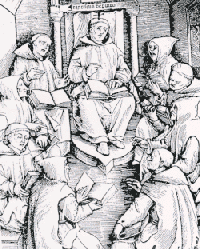Meet the Middle Ages
BackMonasteries and nunneries

Monasteries and nunneries, or convents, were built both in town and in the country-side. In the Nordic countries, monks and nuns from the Order of St Benedict and from the Cistercian Order founded monasteries and nunneries in the country-side. They were like large farms, where monks and nuns cultivated the land. Many monks were also skilled in different crafts - they were for example carpenters, smiths, or leather artisans. Practical work was taken care of by laymen. At the Varnhem Monastery in Västergötland, water-pipes were built so that the monks had running water.
The monks and nuns knew a lot about healing and medicine. Sick and injured people often came to the convents to get medical care. Medicinal herbs grew in the gardens. If someone needed to be bled, the monks could do it. They opened a vein with a knife to let old blood out.
Convents were also meeting-places in the country-side. There were rooms for travellers who wanted to stay overnight. The convents also became cultural centres, where people could talk and read books. The monks helped the peasants to write wills or deeds. Sometimes, political meetings were held at the monasteries.
Many convents owned a number of farms. The peasants who lived on those farms paid rent to the monastery. A manager from the monastery visited the farms regularly, to make sure that all was well and that the tenants paid their rent.
There were several Cistercian monasteries in the Nordic countries during the Middle Ages, around 15 in Sweden alone. There were monasteries in for example Herrevad in Denmark, Nydala (Småland), Alvastra (Östergötland), Varnhem (Västergötland) and Roma (Gotland) in Sweden, and nunneries in Vreta and Askeby in Östergötland. Knudsklostret in Odense, Allhelgonaklostret in Lund and Nidarholm in Trondheim belonged to the Order of St Benedict.
Read more about monasteries and nunneries in "Society. The Church and Town Life. Churches, monasteries and nunneries."